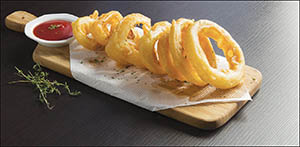Onions are actually in the top five most-eaten vegetables. The average American consumes about 21 pounds every year.
By Alison Crane
Do you need a reason to celebrate? Here it is… June 22, 2024, is National Onion Ring Day! Who doesn’t love a batter-dipped and deep-fried food item that comes in a fun shape? Onion rings are popular in Canada, the United Kingdom, Ireland, Australia, and even some areas in Asia. Of course, we know they are a favorite appetizer in the United States. Let’s face it, onions are the unsung heroes of the vegetable world.
People have been growing and eating onions for close to 7,000 years but eating onion rings does not have quite as long a history. One of the earliest recorded recipes, “Fried Onions with Parmesan Cheese,” is found in a cookbook dating to 1802 by John Mollard. A restaurant chain called The Pig Stand and founded in Oak Cliff, Texas, claims to be one of the inventors of the onion rings dating back to the 1920s. The A&W fast food chain is credited with making the onion ring popular in the 1960s. Whether you like onion rings or prefer your onion powdered, onions are nutritious and versatile
Onions are an edible bulb that grows underneath the soil. They are crunchy and pungent when eaten raw and soft and sweet when cooked. The onion family includes red, white, and yellow onions, pearl onions, scallions (green onion), Ciplline onions, Vidalia’s, shallots, leeks, and garlic.
You can caramelize, grill, sauté, steam, roast, preserve them and enjoy them raw. To quote Shrek, “Onions have layers.” Those layers allow for a lot of versatility in how they are prepared and eaten. While most people do not think of onions first when thinking about vegetables, they are actually in the top five most eaten. The average American eats 21 pounds of onions every year.
Choose onions that are firm and dry with little to no scent and avoid bulbs that have mold, cuts, or bruising. Onions will last longer if not washed until time to be used. To store uncut onions, keep them in a dark, cool, and dry place, and do not store them in a plastic bag because they need good ventilation to last.
Once an onion is cut, refrigerate the unused portion in a tightly sealed container for up to 2-3 days only. When you only need a portion, do not peel the whole onion. Cut off the size you need and peel that part and the remainder will keep longer in the refrigerator if unpeeled. Wrap scallions or sweet onions in plastic before storing to help keep them fresh and prevent their strong odor from flavoring other foods in the fridge. If you chop onions from the top and not the root end, you have a better chance of not crying. You can also try chilling the onions first or cutting them under cold water.
Onions pack a lot of nutrition in that round, gluten-free package. They are fat and cholesterol-free and have negligible amounts of sodium. Onions are a good source of dietary fiber and provide you with Vitamin C which helps keep our immune system strong and helps our body heal quickly. They also are a good source of B Vitamins which help our cells grow and stay healthy. Garlic is also high in allicin, an antioxidant that helps our heart health and protects against cellular damage. With only 32 calories per half-cup serving, you get a lot of nutrition for with very little cost to your calorie count.
Unfortunately, onion rings can add a lot to your calorie count for the day since most of the time they are deep-fried in hot oil. Depending on how they are prepared they can also be high in sodium. Never fear! You can make your own homemade onion rings for yourself and your family. Making them from scratch allows you to control the ingredients and how they are prepared.
I tested some healthier versions of homemade onion rings with my family, and they were a big hit. Here is a recipe that can be done in the oven or an air fryer. Making them from scratch is a little more labor intensive, but you can control the ingredients and get your family involved.
Homemade Oven-Baked Onion Rings
Ingredients:
3/4 cup all-purpose flour
½ -1 tsp paprika
1 tsp salt, divided (can be reduced for low sodium diet, black pepper or other seasonings can be used as a substitute)
½ cup low-fat buttermilk* or low-fat milk
1 egg or 2 egg whites
1 Tbsp olive oil
1 cup panko or whole-wheat breadcrumbs
1 large yellow sweet onion – sliced into ½-inch wide rings
Oil spray, optional
Directions:
Preheat oven to 450ºF if using oven.
In a large plastic bag combine flour, paprika, and ½ tsp of salt.
In a shallow bowl, combine milk, egg, olive oil, ½ tsp of salt, and ¼ cup of the flour mixture and stir until evenly mixed.
In a second bowl, place ½ of the panko or whole-wheat breadcrumbs (save the remaining breadcrumbs for when the first batch starts to get sticky or too low to coat the onion).
Place cut onions into the plastic bag and gently shake until thoroughly coated with the flour mixture.
Drop rings into the buttermilk mixture a few at a time and lightly toss with tongs until coated.
Gently toss them in the panko/whole-wheat breadcrumb bowl until covered with crumbs, carefully lifting them out with a dry fork.
If using an air fryer, spray the basket with oil spray. Place onion rings in a single layer – smaller ones can be placed inside larger rings without touching. (I did do a second layer laid on top to touch as little as possible of the bottom layer and they did not stick together.)
Cook at 400ºF until golden brown and crispy, for about 11-15 minutes. You can spray with cooking oil about halfway through and do not turn the rings over.
If using the oven, place rings onto a parchment paper-lined baking sheet, without touching. Rings can be set inside each other for more space. Spray the rings lightly with cooking oil. Bake in oven for 12-15 minutes until golden brown.
*You can make your own buttermilk by adding 1 Tbsp vinegar or lemon juice to ½ cup milk.
Nutrition
Calories: 193kcal Carbohydrates: 26g Protein: 4 g Fat: 8g Saturated Fat: 1g
Cholesterol: 3mg Sodium: 1208mg Potassium: 260mg Fiber: 2g Sugar: 9g
Vitamin A: 540IU Vitamin C: 7.9IU Calcium: 68mg Iron: 1.4mg
If you would like more information about making your favorite recipes healthier or need other nutrition-related information, contact the Garland County Extension Office at 501-623-6841 or email acrane@uada.edu. Visit our website www.uaex.uadaedu/garland/.
Alison Crane is a Family and Consumer Sciences Agent with the Garland County Extension Service. The University of Arkansas System Division of Agriculture offers all its Extension and Research programs to all eligible persons without regard to race, color, sex, gender identity, sexual orientation, national origin, religion, age, disability, marital or veteran status, genetic information, or any other legally protected status, and is an Affirmative Action/Equal Opportunity Employer.









